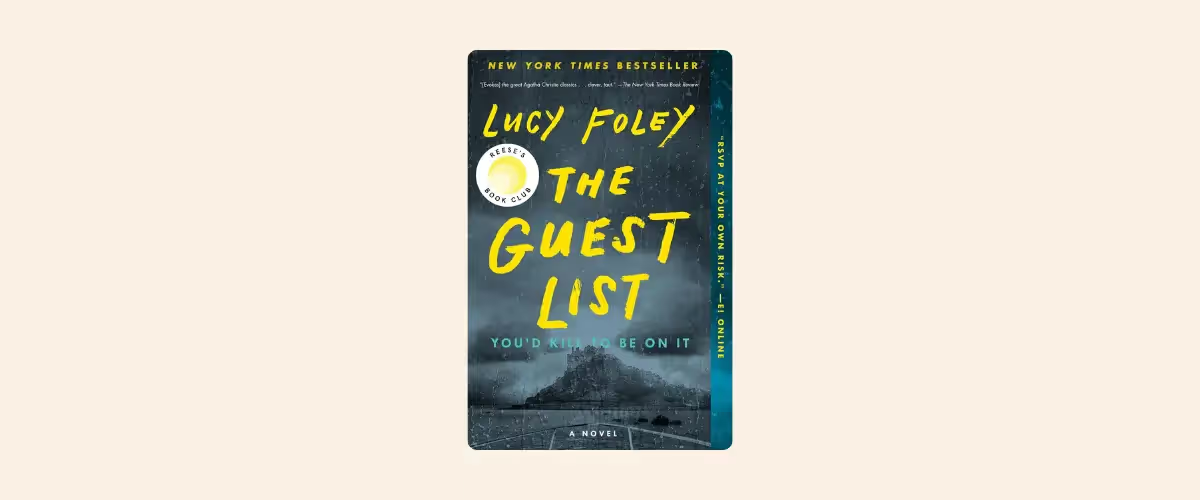You might have heard the term in medias res (sometimes incorrectly referred to as ‘in media res’), perhaps when reading a review or a story breakdown of a movie or TV show. In medias res is a technique that can be applied to any story—even short stories—but it can be especially effective in a novel.
But what do we mean when we talk about something being in medias res, and why would writers make this choice for their story?
Bestselling author of psychological thrillers Amanda Reynolds, one of our writing coaches at The Novelry, is here to explain it all while showing you how to use this tool to your best advantage. With Amanda’s advice and some helpful examples of opening scenes, you can utilize in medias res to ignite your reader’s interest through natural curiosity and keep them turning those pages!
Let’s find out more...
.avif)
What does in medias res mean?
Mentioned briefly in our comprehensive guide to literary terms, in medias res is a Latin phrase that translates to ‘in the middle of things.’
It means your story will not be told in a linear fashion or chronological order, but, at its simplest, will begin at a future point before rewinding back to what came before.
At this point, you might ask how in medias res can benefit the way a writer tells a story. How will we know if we should begin our novel in the middle of things? Will the reader be able to make sense of it? Surely a story should start at the beginning?
The first thing to understand is that in medias res does not refer to the structural midpoint of your story. Instead, it’s about getting into an exciting part of the narrative straight away, without too much preamble. Right from the first page, the reader is dropped directly into the action and asking questions about who, what, where, when, and why.
Another well-worn phrase often offered to writers—one that needs no translation and which you may well be familiar with already—is ‘get in late and leave early.’ (This technique is particularly helpful when writing what could be an awkward sex scene, when foreplay can leap straight to post-coital cigarette!)
.avif)
There are many reasons why writers might want to cut to the chase in their stories, no matter the genre. In medias res doesn’t only make sense in action thrillers, where the opening scene may take place in the middle of a fierce battle or some life-and-death incident.
In medias res scenes have introduced all sorts of stories, kicking them off with a bang and then explaining how the characters got there in so many flashbacks as is necessary.
One of the most well-known examples of it in short-form literature is mystery author Edgar Allan Poe’s ‘The Tell-Tale Heart.’ The opening scene takes place in the middle of a conversation between two characters, with a crime already committed.
Now this is the point. You fancy me mad. Madmen know nothing. But you should have seen me. You should have seen how wisely I proceeded—with what caution—with what foresight—with what dissimulation I went to work!
—Edgar Allan Poe, ‘The Tell-Tale Heart’

Let’s examine how to locate the perfect point for an in medias res opening in your own story and why you might choose to use one.
Know your plot
Think it’s best if your story opens in medias res? Then you will need to know your plot reasonably well. Your hook will provide the initial focus here—that pitchy, pithy sentence or two that encapsulates the premise of your story.
A simple one-page synopsis of your story can help a lot, too—much like the one we use here at The Novelry to help writers nail their best stories in coaching sessions. Producing a hook and a 750-word plan doesn’t mean you have to know every plot beat up front, or even the ending. Plans are very much up for discussion and change, as is your hook, but they show you the arc of your narrative from early on in the planning and how your characters will change. It will likely help highlight your inciting incident, too—the part of the story that affects change for your main character and sets their future path.
As long as you have a plan, any kind of plan, you can start to consider where in medias res falls in your story, and then you can think about how to use it in your opening scene.
.avif)
Know your backstory
Next, you’ll want to ask yourself a few pertinent questions about backstory, which can often get in the way of that snappy beginning!
- Is there a lot of set-up or exposition that may drag the pace?
- Could any of these details be held back until later, to make that opening more propulsive?
- Could they be cut down, or even cut out altogether?
Regardless of the level of your pre-planning—hook and synopsis, or full-blown detailed chapter plan—you may need to accept that you will cut quite a bit from the beginning of your story when you’re editing it in later drafts, as I do myself. That’s all part of the process of finding your story, but don’t worry. None of that early writing is a waste of time, as you will have found out a lot about your characters as you worked on it—as well as some good ideas on the best place for your in medias res beginning.
Award-winning author Chris Whitaker recently held a live writing class for members of The Novelry, and one of the things he discussed was how this cutting process works for him. You might be surprised by how many words he deletes in order to distill his novels (such as his recent New York Times bestseller, All the Colors of the Dark) into their final draft!
Think about how the past informs the present
Our characters exist in a continuum: before, during, and after the events of the story. Only in our imaginations, of course, but in order to feel realistic, they must have a past that informs the narrative’s present—and this forms a vital part of that journey of discovery as we write.
Remember, though, that too much exposition can slow the pace. Ask yourself these two questions before including all those flashbacks:
- Does the reader need to know (all) this?
- And if so, do they need to know (all) this now?
If you answer yes to both of these questions, you can proceed—but do so with caution. Less is more where the context of a character’s history is concerned. Limit it to a need-to-know basis.
In medias res: making it work for you
So, how does in medias res work in practice?
Georgia Summers, bestselling romantasy author and an editor at The Novelry, gave these excellent examples:
For SFF, both YA and adult, there are some great examples—Little Thieves by Margaret Owen starts in the middle of a jewel heist, and Gideon the Ninth by Tamsyn Muir starts with an attempted jailbreak. Empire of the Vampire by Jay Kristoff starts with a conversation between a captor and his prisoner, with the rest of the novel revealing how they got there. I suppose, though, there’s a difference between in medias res action and in medias res story. Gideon the Ninth would come under action, but Empire of the Vampire would come under story.
—Georgia Summers
I love this distinction, as it shows that in medias res doesn’t have to be a high-octane thriller scene filled with action, and that it can be an effective device in different genres. Readers can fill in the backstory later, and will be curious to know what brought the protagonist to the moment in which we find them. Just make sure that the call-back does come, and that the payoff is good!
Prologues that occur in medias res
Kate Riordan, author of historical and suspense fiction and a writing coach at The Novelry, loves the immediacy of a prologue in her writing that takes her readers to a point of in medias res.
It’s like a movie trailer for my story, which hopefully hooks the reader in. Then I go straight back to the inciting incident in chapter one.
—Kate Riordan
Prologues can be a very useful way to foreshadow future events, piquing the reader’s interest in a mystery from early on. Note that Kate then ups the stakes immediately with an inciting incident in her first chapter to keep her readers hooked.
I also like Kate’s ‘movie trailer’ analogy. Some recent examples of in medias res being used in TV and film would be:
- Reacher (season 3, based on Persuader by Lee Child), in which protagonist Jack Reacher saves a young man’s life in a sudden kidnapping attempt by shooting the kidnapper—and then accidentally shooting a police officer—before a chase ensues. By the end of the opening episode, we have gone back in time to discover the truth of events: why Reacher was there at that time, and how all may not have been as it seemed.
- The White Lotus (season 3). The first episode begins with the discovery of a dead body that catapults the viewers directly into the plot, before going back in time. The viewer can try to piece together whose body it might be, and why, over the course of the series.
- The explosive opening of Iron Man (2008) shows titular protagonist Tony Stark traveling across the desert in an armored vehicle that is quickly blown up, leaving him injured and alone in the middle of nowhere. The movie then rewinds to a prior point in the story so we can learn some context about who Tony Stark is and how he came to be in that desert.
{{blog-banner-13="/blog-banners"}}
In the crime and thriller genre
Prologues that occur in medias res work especially well in my own genre of crime and thriller. Sorcha Rose, one of our brilliant editors here at The Novelry, cites the bestselling novel The Guest List by Lucy Foley as a great example of this:
It starts with the wedding, the storm, and the dead body.
—Sorcha Rose on Lucy Foley’s The Guest List

But not all crime novels begin with the crime—or, indeed, a dead body.
As Clare Mackintosh, bestselling crime author and another writing coach here at The Novelry, says:
There’s a noticeable distinction between how in medias res is handled in a thriller or psychological suspense novel, and how it presents in a police procedural, murder investigation, or class crime novel. The latter almost always begins at an intense point of action, frequently in the aftermath of a murder or other serious crime, and so in medias res is easy to execute. It’s less straightforward in psychological suspense, where the tension comes not from what has happened, but what is yet to happen. In these examples, in medias res is achieved through narrative techniques such as prologues or dual timelines.
—Clare Mackintosh
A mysterious opening scene
It’s important to remember that a great in medias res beginning has to walk the line between being mysterious and being outright confusing. We want to arouse curiosity in our reader, not bemuse them.
As Elizabeth Kulhanek, editor of crime and contemporary fiction, explains:
Something to keep in mind is that even though the reader won’t understand everything that’s happening in the scene, they still need enough context to be invested in it. It’s a tricky balance to give them just enough information to understand and care about what’s happening, and then carefully plant more information and/or hints as the scene progresses.
—Elizabeth Kulhanek
We end by reflecting on the beginning (which is the middle)
When done well, in medias res can draw in your reader from the first page—the first line, even—setting the compass for your main character and demonstrating their motivation and the stakes, which must be high. As Kate Riordan says:
For the reader, it’s like you’re already their trusted confidante, and so you’re immediately swept up in their dilemma/conflict.
—Kate Riordan
An in medias res opening scene can set up a premise, create a mood, kick off a conflict, set in motion a quest, or brew up a great drama or a deep emotional dilemma. Your reader is dropped right into the moment with your characters, experiencing events that are just too intriguing to ignore.
Whatever your genre or theme, why not give it a go? See where it takes you! It’s the perfect way to distill the opening of a story into its enticing best version—one that will have your reader held captive, turning the pages to find out not just why these things have happened, but how...
Write your novel with coaching from Amanda Reynolds
If you’re writing crime, suspense, or a psychological thriller and you’d like to benefit from some knowledgeable authorial guidance, you’ll find Amanda a wise and insightful writing coach.
Wherever you are on your writing journey, we can offer the complete pathway from coming up with an idea through to ‘The End.’ With personal coaching, live classes, and step-by-step self-paced lessons to inspire you daily, we’ll help you complete your book with our unique one-hour-a-day method. Learn from bestselling authors and publishing editors to live—and love—the writing life. Sign up and start today. The Novelry is the famous fiction writing school that is open to all!
.avif)


.avif)
.webp)

.avif)